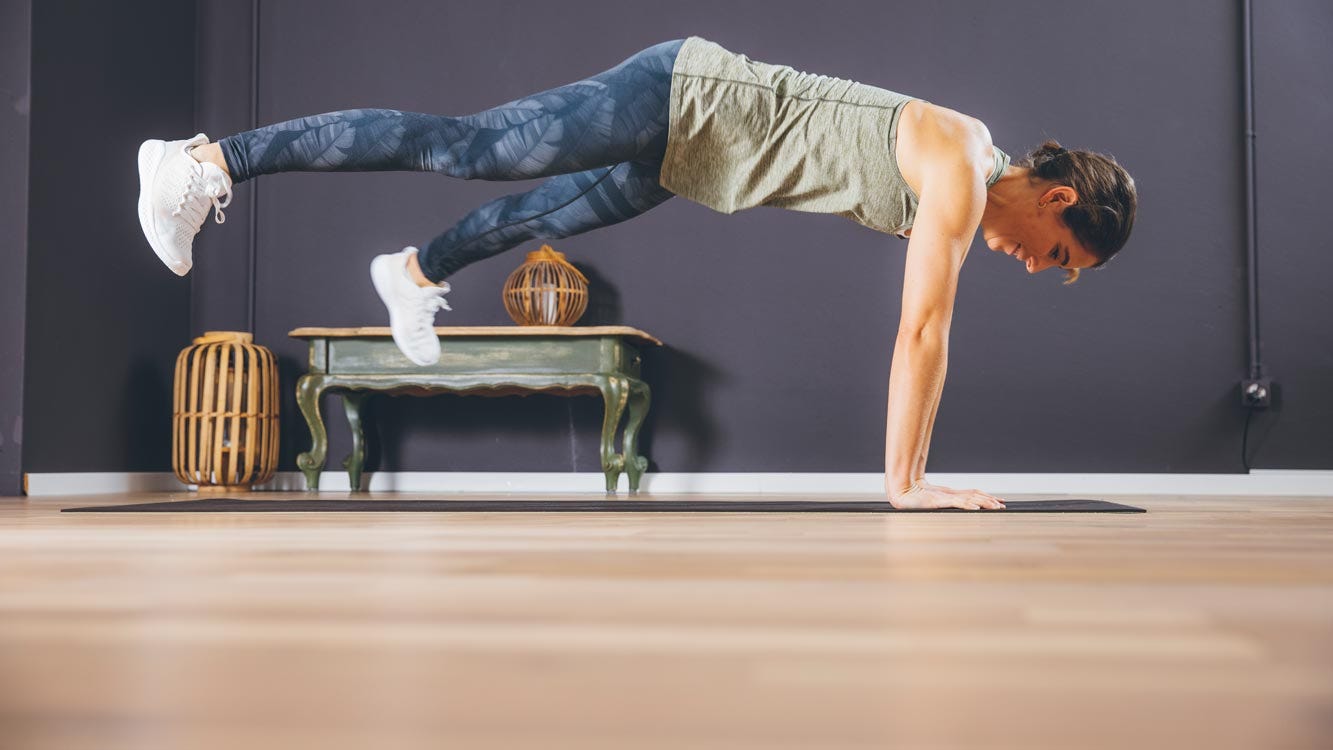How much exercise should we do a week?
While some people are fitness fanatics, others only find time to work out once a week. So, how much exercise should we be doing?

Do we need to train two hours a day or is it enough to exercise once a week? And what’s better: Long and moderate training or short and intensive?
If we had a penny for every new training programme that came onto the market, we’d be rich. Just remember: there’s no one-size-fits-all strategy. “To be healthy, it’s generally advisable to incorporate regular moderate to intensive exercise in your daily routine. How many times you should ideally train each week depends on your goal, your fitness level and the time you have available,” says Manuel Coimbra, sports scientist and personal trainer.
However, there are a few points to bear in mind to make your training effective, efficient and, above all, sustainably healthy.
How much sport is healthy?
The World Health Organisation (WHO) recommends different times depending on the intensity of the exercise. The recommendations of the Swiss Federal Office of Sport are based on these requirements.
- Moderate-intensity physical activity: The WHO recommends that adults aged 18 to 64 years do at least 150 to 300 minutes of moderate-intensity physical activity per week. This includes activities such as cycling, fast walking. dancing, gardening, light housework.
- Vigorous-intensity physical activity: Alternatively, we can train more intensively – but for less time. In this case, the WHO recommends 75 to 150 minutes of vigorous-intensity physical activity a week. This includes, for example, jogging, playing football, high-intensity interval training (HIIT), tennis, intensive cycling or basketball.
- Extra strength training: The WHO also advises that adults that adults strengthen their major muscle groups through strength training two to three times a week, which also helps to improve both coordination and movement patterns.
Exercising consistently is a valuable investment in your health: “Many studies show that exercising protects against lifestyle diseases such as diabetes, cardiovascular diseases, e.g. high blood pressure or heart attacks, various types of cancer or depression,” says Claudio Nigg. Claudio is a professor at the Institute of Sports Science at the University of Bern.
- No matter whether your aim is to improve your stamina, strength or appearance, if you want to make progress you have to train at least three to four times a week.
- Align the intensity of your training to your daily workload: How’s your working week shaping up? Are you already stressed? Do you have enough time to recover?
- Recovery, sufficient sleep and a good diet are key to training success. You need to plan time for all these things.
- Know your limits and listen to your body: Are you rested and ready for your next training session, or do you need more rest and active regeneration?
- The quality of movement is most important. Only increase the intensity once you have the movement right. This way, you’ll stay injury free and achieve your goals in the long term. It’s a good idea to consult an expert now and again to make sure you’re doing the exercises correctly.
- Appearance goals may be motivating in the short term. In the long term, however, it’s better to focus on health and a positive body image. Exercise should become a habit – an essential part of a healthy lifestyle.
How many times should we train a week?
As the name implies, weekend warriors only train at the weekend. And that’s OK, but Manuel Coimbra explains that if you want to build up muscle, improve your stamina or lose weight, you should train at least three, possibly even four times a week.
If you don’t have much time, Manuel recommends that you do “exercise snacks”. These are several short blocks of exercises of 15 to 20 minutes which raise the heart rate and target specific muscles with a few strength exercises, such as jumping jacks, push-ups and air squats. You can also do these short sessions between meetings or in your lunch break.
It’s better to spread sporting activities over the week instead of trying to pack everything into one training session. And the programme varies depending on your goal. Here’s an overview:
-
Staying healthy
If you exercise to promote your health and prevent illness, you should do between150 and 300 minutes of moderate-intensity physical activity a week.
“It’s best to spread this time over three to five sessions per week,” says sports scientist Claudio Nigg.
But that’s not all: you should also do at least two sessions of strength training a week. “A combination of moderate exercise and strength training is ideal for reducing your risk of developing a whole range of illnesses,” says Claudio.
Targeted exercise helps against these diseases in particular:- High blood pressure
- Type 2 diabetes
- Obesity
- Cardiovascular disease
- Cancer (e.g. bladder, breast, bowel, stomach
and kidney cancer) - Prevents fractures/illness due to falls
- Mental illness (reduces the risk of anxiety and depression)
- Cognitive illnesses (reduces the risk of e.g. neurodegenerative diseases such as Alzheimer’s)
-
Losing weight
Diet rather than exercise is actually the most important factor for losing weight,” says Claudio. If you don’t first look at your diet to reduce your calorie intake, you will invest time in sport in vain.
Because if you focus solely on sport and continue to eat as before, you would have to train for hours a day – that’s neither feasible nor healthy for the body.
Nevertheless, exercise helps you to lose weight and, above all, to maintain your desired weight in the long term.
If you want to change your diet and exercise in order to lose weight, you need to do about 300 minutes of moderate-intensity or 150 minutes of vigorous-intensity exercise a week, says Claudio.
Ideally, you should split the training into four or five sessions a week.
To lose weight, personal trainer Manuel Coimbra recommends HIIT workouts (high-intensity interval training), because these offer the perfect combination of endurance and strength exercises.
Stress, however, is counterproductive. And many beginners fall into this trap. “If you over-motivate your body by doing too much sport and are under pressure at work at the same time, you won’t achieve your objective in the long term and, in the worst case, you’ll even gain weight,” says Manuel.
The lack of rest and recovery prevents the body from reducing the stress hormone cortisol, which leads to the body building up fat reserves.
-
Maintaining weight
If you want to maintain your weight, you should train between 150 and 300 minutes a week at a moderate level or between 75 and 150 minutes at an intensive level. Here, too, the time should be split between three to five sessions a week.
Diet also plays an important role here: In order to maintain your weight, you should only supply your body with as many calories as it actually consumes. Eat plenty of fresh vegetables, pulses, fruit and wholegrain carbohydrates. Suitable sources of protein include fish, tofu, eggs and dairy products.
And opt for unsaturated fatty acids such as olive oil, nuts or avocados. Drink at least 1.5 to 2 litres of water a day.
-
Building muscle
If you want to build muscle, you should train two to three times a week with a day’s rest in-between for regeneration.
“For the individual workouts, focus less on how long you train – and more on how many sets and reps you do,” says Claudio. Studies show that three to four sets of an exercise with 10 to 15 reps in each set are most effective for building muscle.
How long a session lasts depends on how fast you do your exercises. It is important to take your time to make sure you do the exercises correctly. If you don’t do the exercises correctly, you can injure yourself and miss your goal that way.
Variety is the key to success. Make sure to train different muscle groups in each session. For example: Train your legs on day 1, then take a rest day. Then train your torso and back on day 2. On day 3, you can train your shoulders and arms.
And vary the exercises you do: It’s good for your muscles to switch things up and vary your training. If the body always receives the same stimulus – the same running route or training programme – it will remain in its current state after an initial improvement.
-
Reducing stress
Exercise is proven to help reduce stress. Moderate activities are particularly suitable here. Experts recommend doing around 150 minutes a week, split over three to five sessions.
Particularly suitable: Daily walks in the wood or forms of movement that also include breathing and meditation, such as yoga, Qigong or Tai-Chi.
Can I make up for a lack of time by increasing the intensity?
This is generally the case – the WHO’s sports recommendations also suggest that intensive training requires only half the weekly time compared to moderate forms of exercise.
These recommendations are based on numerous studies that demonstrate that short, high-intensity interval workouts have the same effect as longer, moderate exercise.
This was demonstrated by a study conducted by the McMaster University in Ontario (Canada): One group trained at a moderate pace for 45 minutes at a time, while the other only exercised for ten minutes, alternating between very slow two-minute units and 20-second sprints. The high-intensity load lasted only one minute overall. The result was that both groups improved their endurance by almost 20%.
So it’s no wonder that high intensity interval training (HIIT) is currently so popular.
A HIIT workout includes elements of endurance and strength, and the exercises are repeated several times at short but very intensive intervals.
How much sport is too much?
“Generally speaking, very sporty people can train up to as many as six times a week,” says Manuel – provided they plan in sufficient time for recovery. If you try to do too much, you run the risk of injury, feel exhausted and tired, and won’t get anywhere with your training.
Sufficient sleep and a balanced diet are key to successful training. Furthermore, your weekly sporting activities need to fit with your daily routine: “If you’re already stressed at work, I wouldn’t recommend trying to train at a high intensity four times a week.”
It’s all about finding a good balance. “You have to learn to listen to your body. If you’re tired out and have painful muscles, you should rest for another day or at least train at a lower intensity,” says Manuel.
When’s the best time of day to do sport?
Studies show that the effect after exercise – regardless of the time of day – is similar. Based on this data, it makes no difference when you exercise.
However, working out too late in the evening can disturb your sleep. “So we recommend not doing any sport at least two hours before going to bed, especially no intensive physical activities,” says Claudio. The body needs to rest before going to sleep.
When is the best time for women to exercise during their cycle?
Numerous experts say that if you want to time your training correctly, you should pay less attention to the time of day and more to the right time in your hormonal cycle.
Performance in particular fluctuates during a woman’s cycle. So more and more competitive female sportspeople are following a cycle-based training programme. This means they train harder or take it easier depending on their current hormonal balance.
In the first half of the cycle, when the level of the female sex hormone oestrogen is high, women can train harder and build muscle. During this time, the female body is in an anabolic state.
“We still don’t have a great deal of data in this rea of research,” says Claudio, “but initial studies being conducted by our institute show that women can train throughout their cycle – and still achieve good results.” However, cycles vary from woman to woman. So women should listen to their body and adjust the intensity of their training according to how they feel.
Men also experience hormonal differences, but their “cycle” is only a day long. The level of the sex hormone testosterone is highest in the morning. So some researchers argue that men should train in the morning in order to achieve the best possible athletic performance.
It makes perfect sense for both men and women to adapt their training to individual fluctuations in energy levels, sleep quality, stress levels and subjective feelings of exertion. This is where autoregulated training methods come into play – approaches that, according to Claudio, are particularly efficient. You can flexibly adapt the intensity of your training to your daily form.
There are two approaches: Training can either be structured based on an individual’s subjective perception of exertion – in other words, how strenuous the workout feels to them. Alternatively, objective data, such as heart rate variability, can be measured. This data indicates how well the body has recovered. This helps avoid overexertion and allows for more personalised training.


